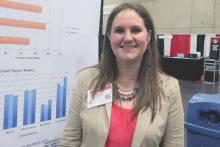SAN DIEGO – College-aged men and women had positive attitudes toward human papillomavirus vaccination, yet perceived cost and access barriers factored into their decision to receive the vaccine, results from a large survey found.
“The people reporting the higher barrier scores were the same ones who had the highest intent to receive the vaccine,” Dr. Casey Nicol, lead study author, said in an interview at the annual meeting of the Society of Gynecologic Oncology. “It’s a shame, because these are people who want it, and there are ways for them to get vaccinated; they just don’t know about them. I think there’s a big opportunity for education and public health outreach.”
Dr. Nicol and her associates sent an online survey to a random sample of 3,000 students at the University of Virginia, Charlottesville, who were between 18 and 26 years old. The survey included questions about their human papillomavirus (HPV) vaccination status and intention as well as 17 items from the modified Carolina HPV Immunization Attitudes and Beliefs Scale (CHIAS).
“A lot of the previous research I could find focused more on parental attitudes about HPV vaccination rather than adolescent and young adult attitudes,” said Dr. Nicol, who is a resident in the department of obstetrics and gynecology at the University of Virginia.
Of the 3,000 surveys sent, 776 were completed and used in the final analysis, for a response rate of 26%. More than two-thirds of the respondents (70%) were women, and their mean age was 20 years. In all, 67% of students reported having received at least one HPV vaccination, and the proportion was higher for women, compared with men (75% vs. 51%, respectively).
“In our college population we found that the vaccination rates were not as bad as we expected,” Dr. Nicol said. “It was about double the national average for our women and about 20 times the national average for our men.”
No sex differences were observed in responses to 14 of the 17 CHIAS items, and CHIAS factor means for men and women did not differ for any of the five factor groupings, which included barriers, harms, effectiveness, risk denial, and uncertainty.
Dr. Nicol reported that the barriers score was the factor most strongly associated with vaccination intent “today.” It was also strongly associated with vaccination intent for “the next 6 months” (P = .001).
Items in the barriers factor category included the following:
• “It would be hard to find a provider or clinic that would be easy to get to for getting vaccinated against HPV.”
• “It would be hard to find a provider or clinic where I could afford the HPV vaccine.”
• “It would be hard to find a provider or clinic that has the HPV vaccine available.”
• “It would be hard to find a provider or clinic where I don’t have to wait a long time to get an appointment to get vaccinated.”
Dr. Nicol said that the findings underscore the importance of decreasing cost and access barriers in order to improve HPV vaccination rates among young adults.
“If you don’t offer the HPV vaccine at your office, at least provide your patients with” cost information and the “location of the clinics that do have it available,” she advised. “It seems like that would increase the prevalence of more students getting vaccinated.”
Dr. Nicol reported having no relevant financial disclosures.


